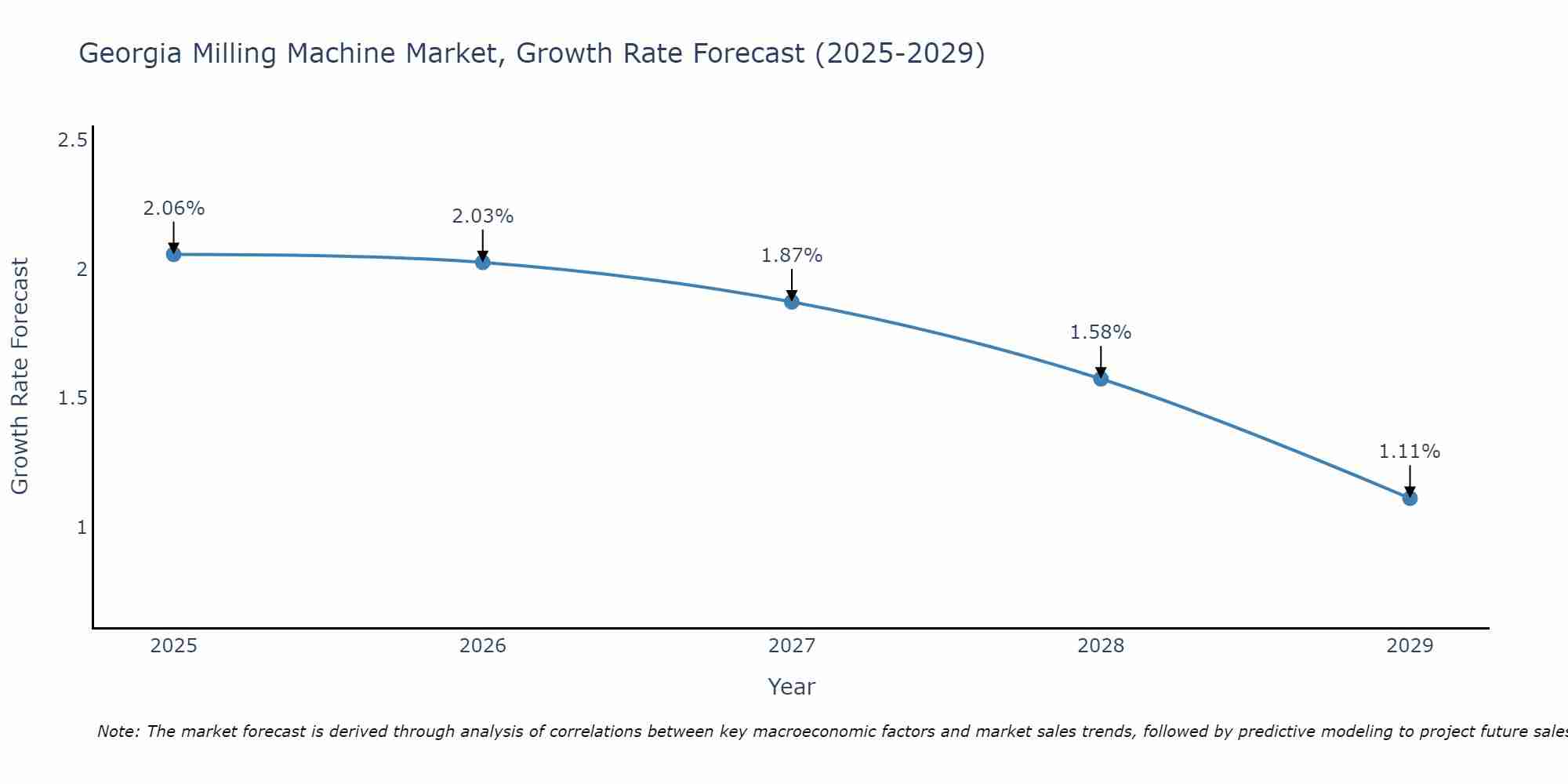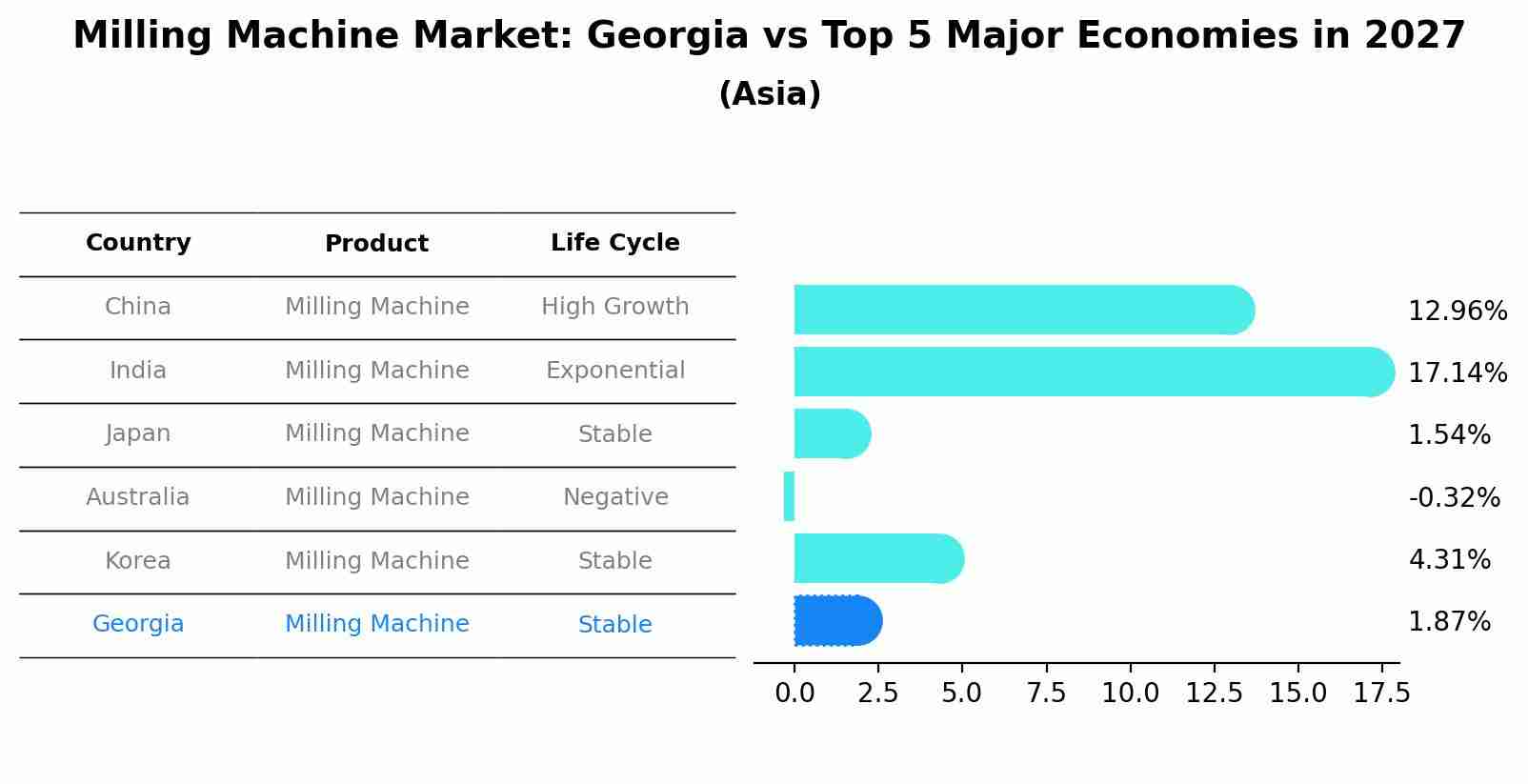Georgia Milling Machine Market (2025-2031) Outlook | Analysis, Revenue, Industry, Share, Growth, Size, Trends, Companies, Forecast & Value
| Product Code: ETC430196 | Publication Date: Oct 2022 | Updated Date: Aug 2025 | Product Type: Market Research Report | |
| Publisher: 6Wresearch | No. of Pages: 75 | No. of Figures: 35 | No. of Tables: 20 | |
Georgia Milling Machine Market Size Growth Rate
The Georgia Milling Machine Market may undergo a gradual slowdown in growth rates between 2025 and 2029. Although the growth rate starts strong at 2.06% in 2025, it steadily loses momentum, ending at 1.11% by 2029.

Milling Machine Market: Georgia vs Top 5 Major Economies in 2027 (Asia)
By 2027, the Milling Machine market in Georgia is anticipated to reach a growth rate of 1.87%, as part of an increasingly competitive Asia region, where China remains at the forefront, supported by India, Japan, Australia and South Korea, driving innovations and market adoption across sectors.

Georgia Milling Machine Market Overview
The Georgia milling machine market serves industries such as manufacturing, aerospace, automotive, and construction by providing a variety of milling machines for precision machining, cutting, and shaping of metal and non-metal materials. These milling machines include vertical mills, horizontal mills, CNC (computer numerical control) mills, and specialized milling equipment designed for specific machining tasks and production requirements. With Georgia strong manufacturing base and engineering expertise, the demand for milling machines is increasing, driving market expansion and innovation in machine design, automation, and digital manufacturing technologies.
Drivers of the market
In Georgia, the milling machine market is influenced by the demand for precision machining solutions and manufacturing automation in industries such as automotive, aerospace, and mold making. Milling machines are used to remove material from a workpiece to create complex shapes and features with high accuracy and surface finish. With the increasing emphasis on productivity, quality control, and time-to-market in Georgia manufacturing sector, the demand for milling machines is on the rise. Moreover, advancements in machine tool design, CNC (computer numerical control) technology, and cutting tool materials drive market growth by offering efficient and versatile machining solutions to manufacturers in Georgia.
Challenges of the market
In the Georgia Milling Machine Market, challenges include meeting the demand for high-precision machining solutions for metalworking, aerospace, and automotive industries. Milling machine manufacturers must innovate to develop machines that offer accuracy, productivity, and flexibility for various machining operations. Additionally, addressing concerns about milling machine maintenance, operator training, and tooling costs poses challenges for market players. Moreover, market competition and pricing pressures from global machine tool suppliers add complexity to this sector, requiring continuous technology advancement and customer support efforts to stay competitive in the market.
Government Policy of the market
In support of manufacturing and machining industries, the Georgia government has implemented policies to promote the milling machine market. These policies may include workforce training programs, technology transfer initiatives, and investment incentives to enhance Georgia capabilities in producing high-precision milling equipment and meet the needs of diverse industrial sectors such as aerospace, automotive, and construction.
Key Highlights of the Report:
- Georgia Milling Machine Market Outlook
- Market Size of Georgia Milling Machine Market, 2024
- Forecast of Georgia Milling Machine Market, 2031
- Historical Data and Forecast of Georgia Milling Machine Revenues & Volume for the Period 2021-2031
- Georgia Milling Machine Market Trend Evolution
- Georgia Milling Machine Market Drivers and Challenges
- Georgia Milling Machine Price Trends
- Georgia Milling Machine Porter's Five Forces
- Georgia Milling Machine Industry Life Cycle
- Historical Data and Forecast of Georgia Milling Machine Market Revenues & Volume By Type for the Period 2021-2031
- Historical Data and Forecast of Georgia Milling Machine Market Revenues & Volume By Horizontal Milling Machines for the Period 2021-2031
- Historical Data and Forecast of Georgia Milling Machine Market Revenues & Volume By Vertical Milling Machines for the Period 2021-2031
- Historical Data and Forecast of Georgia Milling Machine Market Revenues & Volume By End-Use for the Period 2021-2031
- Historical Data and Forecast of Georgia Milling Machine Market Revenues & Volume By Automotive for the Period 2021-2031
- Historical Data and Forecast of Georgia Milling Machine Market Revenues & Volume By Aerospace & Defense for the Period 2021-2031
- Historical Data and Forecast of Georgia Milling Machine Market Revenues & Volume By Construction Equipment for the Period 2021-2031
- Historical Data and Forecast of Georgia Milling Machine Market Revenues & Volume By Power & Energy for the Period 2021-2031
- Historical Data and Forecast of Georgia Milling Machine Market Revenues & Volume By Industrial for the Period 2021-2031
- Historical Data and Forecast of Georgia Milling Machine Market Revenues & Volume By Others for the Period 2021-2031
- Georgia Milling Machine Import Export Trade Statistics
- Market Opportunity Assessment By Type
- Market Opportunity Assessment By End-Use
- Georgia Milling Machine Top Companies Market Share
- Georgia Milling Machine Competitive Benchmarking By Technical and Operational Parameters
- Georgia Milling Machine Company Profiles
- Georgia Milling Machine Key Strategic Recommendations
Frequently Asked Questions About the Market Study (FAQs):
1 Executive Summary |
2 Introduction |
2.1 Key Highlights of the Report |
2.2 Report Description |
2.3 Market Scope & Segmentation |
2.4 Research Methodology |
2.5 Assumptions |
3 Georgia Milling Machine Market Overview |
3.1 Georgia Country Macro Economic Indicators |
3.2 Georgia Milling Machine Market Revenues & Volume, 2021 & 2031F |
3.3 Georgia Milling Machine Market - Industry Life Cycle |
3.4 Georgia Milling Machine Market - Porter's Five Forces |
3.5 Georgia Milling Machine Market Revenues & Volume Share, By Type, 2021 & 2031F |
3.6 Georgia Milling Machine Market Revenues & Volume Share, By End-Use, 2021 & 2031F |
4 Georgia Milling Machine Market Dynamics |
4.1 Impact Analysis |
4.2 Market Drivers |
4.2.1 Technological advancements in milling machines |
4.2.2 Increasing demand for precision machining in industries like aerospace and automotive |
4.2.3 Growing adoption of CNC milling machines for enhanced productivity |
4.3 Market Restraints |
4.3.1 High initial investment required for purchasing milling machines |
4.3.2 Limited skilled workforce in operating advanced milling machines |
4.3.3 Fluctuating raw material prices impacting manufacturing costs |
5 Georgia Milling Machine Market Trends |
6 Georgia Milling Machine Market, By Types |
6.1 Georgia Milling Machine Market, By Type |
6.1.1 Overview and Analysis |
6.1.2 Georgia Milling Machine Market Revenues & Volume, By Type, 2021-2031F |
6.1.3 Georgia Milling Machine Market Revenues & Volume, By Horizontal Milling Machines, 2021-2031F |
6.1.4 Georgia Milling Machine Market Revenues & Volume, By Vertical Milling Machines, 2021-2031F |
6.2 Georgia Milling Machine Market, By End-Use |
6.2.1 Overview and Analysis |
6.2.2 Georgia Milling Machine Market Revenues & Volume, By Automotive, 2021-2031F |
6.2.3 Georgia Milling Machine Market Revenues & Volume, By Aerospace & Defense, 2021-2031F |
6.2.4 Georgia Milling Machine Market Revenues & Volume, By Construction Equipment, 2021-2031F |
6.2.5 Georgia Milling Machine Market Revenues & Volume, By Power & Energy, 2021-2031F |
6.2.6 Georgia Milling Machine Market Revenues & Volume, By Industrial, 2021-2031F |
6.2.7 Georgia Milling Machine Market Revenues & Volume, By Others, 2021-2031F |
7 Georgia Milling Machine Market Import-Export Trade Statistics |
7.1 Georgia Milling Machine Market Export to Major Countries |
7.2 Georgia Milling Machine Market Imports from Major Countries |
8 Georgia Milling Machine Market Key Performance Indicators |
8.1 Average machine utilization rate |
8.2 Number of new product innovations in the milling machine market |
8.3 Percentage of manufacturers offering training programs for milling machine operators |
9 Georgia Milling Machine Market - Opportunity Assessment |
9.1 Georgia Milling Machine Market Opportunity Assessment, By Type, 2021 & 2031F |
9.2 Georgia Milling Machine Market Opportunity Assessment, By End-Use, 2021 & 2031F |
10 Georgia Milling Machine Market - Competitive Landscape |
10.1 Georgia Milling Machine Market Revenue Share, By Companies, 2024 |
10.2 Georgia Milling Machine Market Competitive Benchmarking, By Operating and Technical Parameters |
11 Company Profiles |
12 Recommendations |
13 Disclaimer |
- Single User License$ 1,995
- Department License$ 2,400
- Site License$ 3,120
- Global License$ 3,795
Search
Related Reports
- Australia IT Asset Disposal Market (2025-2031) | Strategy, Consumer Insights, Analysis, Investment Trends, Opportunities, Growth, Size, Share, Industry, Revenue, Segments, Value, Segmentation, Supply, Forecast, Restraints, Outlook, Competition, Drivers, Trends, Demand, Pricing Analysis, Competitive, Strategic Insights, Companies, Challenges
- UAE Building Thermal Insulation Market Outlook (2025-2031) | Revenue, Companies, Share, Trends, Growth, Size, Forecast, Industry, Analysis & Value
- Portugal Electronic Document Management Market (2025-2031) | Strategy, Consumer Insights, Analysis, Investment Trends, Opportunities, Growth, Size, Share, Industry, Revenue, Segments, Value, Segmentation, Supply, Forecast, Restraints, Outlook, Competition, Drivers, Trends, Demand, Pricing Analysis, Competitive, Strategic Insights, Companies, Challenges
- France Electronic Document Management Market (2025-2031) | Strategy, Consumer Insights, Analysis, Investment Trends, Opportunities, Growth, Size, Share, Industry, Revenue, Segments, Value, Segmentation, Supply, Forecast, Restraints, Outlook, Competition, Drivers, Trends, Demand, Pricing Analysis, Competitive, Strategic Insights, Companies, Challenges
- Portugal Occupational Health & Safety Services Market (2025-2031) | Strategy, Consumer Insights, Analysis, Investment Trends, Opportunities, Growth, Size, Share, Industry, Revenue, Segments, Value, Segmentation, Supply, Forecast, Restraints, Outlook, Competition, Drivers, Trends, Demand, Pricing Analysis, Competitive, Strategic Insights, Companies, Challenges
- Netherlands Occupational Health and Safety Services Market (2025-2031) | Strategy, Consumer Insights, Analysis, Investment Trends, Opportunities, Growth, Size, Share, Industry, Revenue, Segments, Value, Segmentation, Supply, Forecast, Restraints, Outlook, Competition, Drivers, Trends, Demand, Pricing Analysis, Competitive, Strategic Insights, Companies, Challenges
- Belgium and Luxembourg Facility Management Market (2025-2031) | Strategy, Consumer Insights, Analysis, Investment Trends, Opportunities, Growth, Size, Share, Industry, Revenue, Segments, Value, Segmentation, Supply, Forecast, Restraints, Outlook, Competition, Drivers, Trends, Demand, Pricing Analysis, Competitive, Strategic Insights, Companies, Challenges
- Russia Women Intimate Apparel Market (2025-2031) | Strategy, Consumer Insights, Analysis, Investment Trends, Opportunities, Growth, Size, Share, Industry, Revenue, Segments, Value, Segmentation, Supply, Forecast, Restraints, Outlook, Competition, Drivers, Trends, Demand, Pricing Analysis, Competitive, Strategic Insights, Companies, Challenges
- Africa Chocolate Market (2025-2031) | Size, Share, Trends, Growth, Revenue, Analysis, Forecast, industry & Outlook
- Global Hydroxychloroquine And Chloroquine Market (2025-2031) | Industry, Trends, Size, Outlook, Growth, Value, Companies, Revenue, Analysis, Share, Forecast
Industry Events and Analyst Meet
Our Clients
Whitepaper
- Middle East & Africa Commercial Security Market Click here to view more.
- Middle East & Africa Fire Safety Systems & Equipment Market Click here to view more.
- GCC Drone Market Click here to view more.
- Middle East Lighting Fixture Market Click here to view more.
- GCC Physical & Perimeter Security Market Click here to view more.
6WResearch In News
- Doha a strategic location for EV manufacturing hub: IPA Qatar
- Demand for luxury TVs surging in the GCC, says Samsung
- Empowering Growth: The Thriving Journey of Bangladesh’s Cable Industry
- Demand for luxury TVs surging in the GCC, says Samsung
- Video call with a traditional healer? Once unthinkable, it’s now common in South Africa
- Intelligent Buildings To Smooth GCC’s Path To Net Zero













